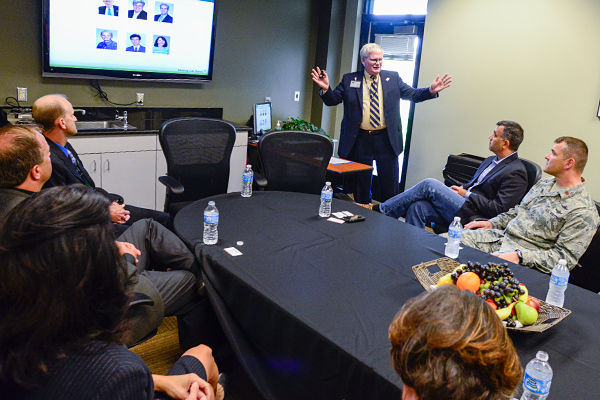Army Sgt. Danny Swank’s lower right leg was amputated following dozens of surgeries to try to save the limb severely damaged when a grenade exploded inside his Humvee in Kandahar, Afghanistan. Joe Hutchinson’s lower leg was blown off by a roadside bomb when he served as a soldier in the Iraq War.
Both veterans participate in USF studies seeking to improve the quality of lives of combat wounded warriors through better prosthetics. The USF School of Physical Therapy & Rehabilitation Sciences specializes in research to improve prosthetic options for those who lose limbs from traumatic injury or diseases – including soldiers and veterans reintegrating into society.

Combat veteran Joseph Hutchinson, wearing an advanced knee prosthetic designed to more smoothly mimic a natural gait, walks up and down stairs.
With the help of Swank and Hutchinson, the school recently offered a behind-the-scenes look at its programs and research to help amputees resume leading active lives, including engaging in rigorous athletics or returning to the workforce, school or active duty. The Walk With a Warrior event was hosted by William S. Quillen, PT, DPT, PhD, FACSM, associate dean and director of the USF School of Physical Therapy & Rehabilitation Sciences. Attendees included former enlisted members of Air Force, Marine Corps and Navy as well as representatives from foundations supporting veterans and the Greater Tampa Chamber of Commerce Military Affairs Council.
“Our goal is to do our best to maximize the function of prostheses, whether they are used for athletic pursuits like running, cycling and aquatics or activities of daily living,” said Jason Highsmith, PT, DPT, CP assistant professor of physical therapy.

Jason Highsmith (center), assistant professor at the USF School of Physical Therapy & Rehabilitation Sciences, explains some of the school’s advanced prosthetics research.
Hutchinson participated in USF’s study comparing the effectiveness of two microprocessor-controlled prosthetic knees — the gold standard C-Leg® and the new Genium™ knee joint, designed to more closely mimic natural gait. The study was funded by the Florida High-Tech Corridor and manufacturer Otto Bock. The study was funded by the Florida High-Tech Corridor and manufacturer Otto Bock.
During the event, Hutchinson demonstrated the climbing and descending stairs with the Genium knee he wears, while Highsmith explained how the prosthetic knee’s biotechnology responds to environmental inputs to make motion more intuitive.
“The microprocessor knee is figuring out what Joe wants to do next,” Highsmith said. “Based on analysis of the speed and angles of his movements, the technology senses he’s about to go down the stairs, so the motion of the prosthetic slows accordingly.” .
An upcoming Department of Defense-funded randomized trial led by Highsmith will evaluate which of three different types of high-tech multifunctional prosthetic feet are best for highly mobile soldiers and veterans with below-the-knee amputations.

William S. Quillen, DPT, director of the USF School of Physical Therapy & Rehabilitation Sciences, presented an overview of the school’s applied research projects to representatives of military and veterans organizations.
Swank, training to scale Africa’s Mt. Kilimanjaro with several other combat-wounded veterans in January, plans to enroll in the study.
“This study could benefit guys who want to return to active duty by fitting them with prostheses that help them do their job as well as before” they lost limbs,” Swank said.
That includes young amputee soldiers who want the option of returning to the battlefield.
As they work on determining which prosthesis comes closest to a real foot in performing high-intensity tactical maneuvers like running, jumping, climbing and crawling, Highsmith emphasizes that the research has applications for civilians as well.
The same knowledge used to develop a prosthetic that can help soldiers more efficiently maneuver across war zone terrain can be applied to people who want to move better in their own homes and work environments, or remain competitive in sports they enjoy, he said.

Faculty members at the USF School of Physical Therapy & Rehabilitation Sciences have attracted more than $3 million in funding from federal agencies, the state, and industry partners The state of Florida recently provided $500,000 of recurring funding to support a comprehensive range of interdisciplinary research in prosthetics and orthotics optimization, musculoskeletal disorders, traumatic brain injury, and balance and movement disorders.
Story by Anne DeLotto Baier, and photos by Eric Younghans, USF Health Communications
